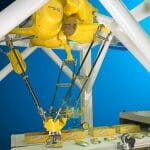Signal towers are traffic lights for the flow of production in a factory. They are the flashing lights on top of many machines, ignored as long as they are green but triggering action when they are amber or red. Today there are many variants to choose from with options for the size, brightness, mounting and enclosure. Signal towers are used to give status signals, to warn of an impending problem or to signal one that has already happened. Their use can reduce downtime and in some cases achieve a safer working environment for machine operators.
Most modern signal towers use LED bulbs for good reasons – their lifetime is 60,000 hours or more. Furthermore they do not suddenly fail and they use around 90% less energy compared to incandescent bulbs. Up to 5 colours can be stacked. Usually green signifies normal running, amber for a warning and red for stop. In addition white and blue modules can be added, for example to signify waiting, loading or off-load. There are options for supply voltages of 24V AC or DC, and 90 to 240V AC, the customer choice being made on convenience and possibly the extra safety given by the low voltage of 24V.
Visibility from a distance.
Brightness and visibility is a difficult area for quantitative assessment as it depends on the machine location and the ambient light levels. Signal towers vary in diameter from 25 to 100mm and obviously the larger the tower the better the visibility from a distance. Towers for office based machinery and work stations will tend to be at the lower end. Machinery on a large factory floor would be likely to use towers of 70 to 100mm diameter. Visibility is aided in the detailed design of the light modules. Here specialist manufacturer Patlite uses a dual reflection system and a hybrid prism-cut lens in light-translucent resin. Most models have the option of either continuous light or flashing ate a rate around 1 per second which gives a stronger visual impact.
Mounting options.
Installation and mounting brings in another set of options. The non-illuminated base of the signal tower has colour options of ivory-white, silver or black which can be chosen to best match the machine appearance. Mounting directly by the base is the lowest cost option although access for fixing bolts and cabling is required from below. Pole mounting allows the signal tower to be raised for increased visibility. If wall mounting is required, a standard signal tower can be adapted by a wall mounting bracket. Alternatively there are signal towers with a flat ‘’back’’ that mount directly onto a vertical surface. Where there are installations with many signal towers, some models such as the Patlite LU5 (50mm) and LU7 (70mm) are designed in a modular way so that colours can be removed and re-sequenced on site without changing the wiring.
Another possibility is to include an audible alarm. These typically give outputs at 85 or 90 dB measured at 1m. One of two different buzzer sounds can be selected to set the optimum noise that will be noticed in the environment. A further option is to be able to turn down the sound level should it be intrusive.
Clean environments.
Many factories are involved in food, drink or pharmaceutical production and here cleanliness is critical. Adapted signal towers such as the Patlite LS7 have smooth external surfaces to avoid the accumulation of dirt, and a high enclosure at IP67k suiting a washdown environment. There are no exposed screw fixings and the clear outer cover in shock resistant polycarbonate is especially formulated to withstand oil mist cracking. As with other signal towers, up to 5 colours and 2 alarm tones are possible.
Increased emphasis on safety and reduction in operating personnel has caused growth in the signal tower market with the consequence of new variants developed to suit market niches. There are explosion safe signal towers suitable for use in ATEX Zone 1, Zone 2 and Zone 22. One of these models even has provision for a recorded voice alert message up to 63 seconds long. The addition of a voice message is also possible on other non-ATEX towers. Rather than the standard LED light module, special strobe modules can be specified which give a double flash of very high intensity at five times higher brightness. Another adaption to the signal tower design is to build 4 colours into one single light module. This compact arrangement appears white when de-energised and takes any colour from red, amber, green and blue when energised accordingly.
Where cabling becomes a problem in large plant installations, wireless data transmission between signal towers and a receiver is available. A transmitter with indicator is fitted to the top of the signal tower and this communicates with computers at a supervisory level. Networking of signal towers including connection with RS232 and USB is another possibility.
Patlite was founded in 1947 and today employs 600 people worldwide with owned subsidiaries in the USA, Germany, Singapore, Korea and China. As well as signal towers, Patlite design and manufacture signal lights, beacons, audible alarms and LED workplace lighting. Markets include all sorts of machinery, particularly printing, packaging, food processing, mechanical handling and PCB production. In the UK the Patlite range is supported and sold by the Techdrives Division of Lenze Ltd, www.techdrives.co.uk.









Leave a Reply